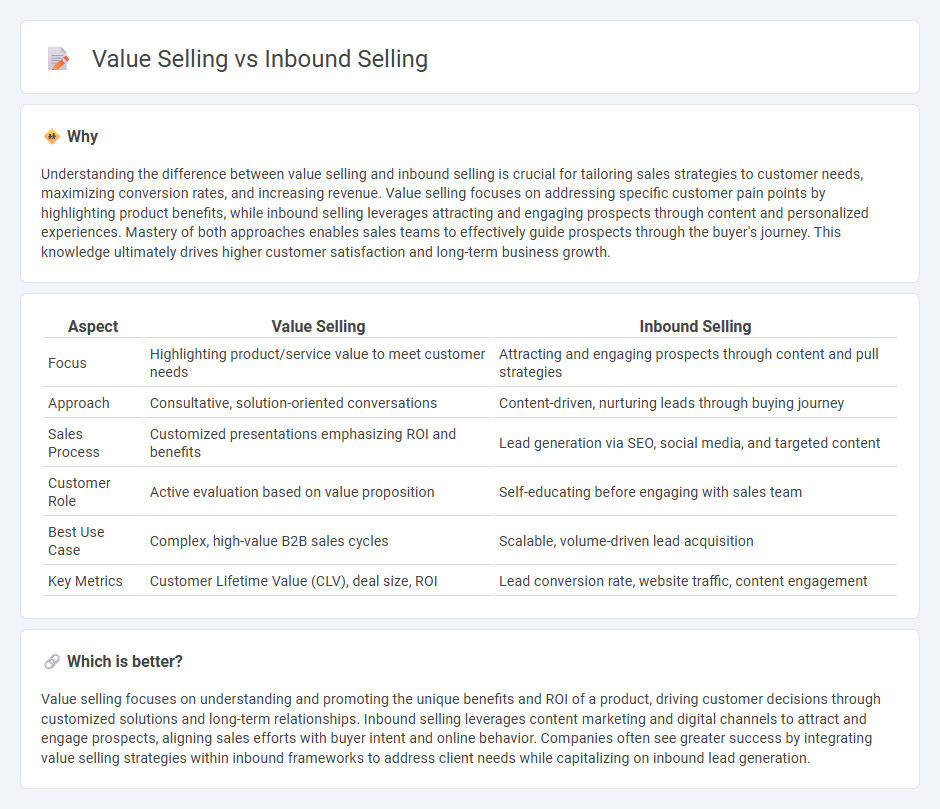
Value selling focuses on highlighting the unique benefits and ROI a product or service delivers to the customer, fostering trust and long-term relationships. Inbound selling prioritizes attracting qualified leads through content marketing, personalized engagement, and addressing buyer needs early in the journey. Explore how combining these sales strategies can maximize revenue and customer satisfaction.
Why it is important
Understanding the difference between value selling and inbound selling is crucial for tailoring sales strategies to customer needs, maximizing conversion rates, and increasing revenue. Value selling focuses on addressing specific customer pain points by highlighting product benefits, while inbound selling leverages attracting and engaging prospects through content and personalized experiences. Mastery of both approaches enables sales teams to effectively guide prospects through the buyer's journey. This knowledge ultimately drives higher customer satisfaction and long-term business growth.
Comparison Table
| Aspect | Value Selling | Inbound Selling |
|---|---|---|
| Focus | Highlighting product/service value to meet customer needs | Attracting and engaging prospects through content and pull strategies |
| Approach | Consultative, solution-oriented conversations | Content-driven, nurturing leads through buying journey |
| Sales Process | Customized presentations emphasizing ROI and benefits | Lead generation via SEO, social media, and targeted content |
| Customer Role | Active evaluation based on value proposition | Self-educating before engaging with sales team |
| Best Use Case | Complex, high-value B2B sales cycles | Scalable, volume-driven lead acquisition |
| Key Metrics | Customer Lifetime Value (CLV), deal size, ROI | Lead conversion rate, website traffic, content engagement |
Which is better?
Value selling focuses on understanding and promoting the unique benefits and ROI of a product, driving customer decisions through customized solutions and long-term relationships. Inbound selling leverages content marketing and digital channels to attract and engage prospects, aligning sales efforts with buyer intent and online behavior. Companies often see greater success by integrating value selling strategies within inbound frameworks to address client needs while capitalizing on inbound lead generation.
Connection
Value selling focuses on highlighting the unique benefits and ROI a product offers, while inbound selling leverages customer-driven interest through tailored content and engagement. Both strategies prioritize understanding customer needs and delivering personalized solutions that enhance perceived value. Integrating value selling within inbound methodologies increases conversion rates by aligning product benefits with buyer intent and information-seeking behavior.
Key Terms
**Inbound Selling:**
Inbound selling centers on attracting and engaging prospects through personalized content, addressing their specific pain points and needs to guide them naturally through the buyer's journey. This strategy leverages digital tools like CRM systems, marketing automation, and social media to create meaningful interactions that convert leads more effectively. Discover how inbound selling can transform your sales approach by fostering trust and long-term customer relationships.
Lead Qualification
Inbound selling emphasizes identifying and nurturing leads through personalized engagement based on their interests and behaviors, ensuring a natural progression to conversion. Value selling prioritizes understanding the specific challenges and goals of a lead to tailor solutions that demonstrate clear business value and ROI. Explore the nuances of lead qualification in inbound and value selling to optimize your sales strategy effectively.
Buyer Persona
Inbound selling emphasizes attracting and engaging potential customers by aligning content and communication with the buyer persona's needs, interests, and behaviors throughout their journey. Value selling centers on demonstrating how a product or service delivers specific benefits and ROI tailored to the buyer persona's pain points and business goals. Explore detailed strategies to effectively integrate both approaches to maximize customer acquisition and satisfaction.
Source and External Links
What is Inbound Sales? Methodology, Strategies & More - Salesloft - Inbound sales is a modern sales framework that creates personalized buying experiences for customers by identifying, connecting with, exploring the needs of, and advising potential buyers who have shown interest through digital channels.
Inbound Selling: How to Meet Buyers Where They Are - Docket AI - Inbound selling is a customer-focused approach where sales reps attract, engage, and guide potential customers by understanding their needs and offering relevant, helpful information instead of pushing products with aggressive tactics.
Inbound Sales: How to Sell the Way Prospects Buy - HubSpot Blog - Inbound sales is a customer-centric methodology that focuses on providing value and building trust with prospects through personalized, empathetic interactions, allowing customers to come to you via content and digital channels.
 dowidth.com
dowidth.com